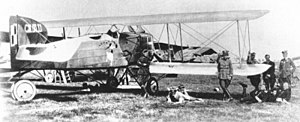Breguet 14
| Breguet 14 | |
|---|---|
 |
|
| Polish Breguet 14 during the Kiev Offensive | |
| Role | Bomber |
| Manufacturer | Breguet |
| Designer | Marcel Vuillierme |
| First flight | November 21, 1916 |
| Introduction | 1917 |
| Primary users |
Aéronautique Militaire US Army Air Service Polish Air Force Royal Thai Air Force |
| Produced | 1916-1928 |
| Number built | ca 7,800 |
The Breguet 14 was a French biplane bomber and reconnaissance aircraft of World War I. It was built in very large numbers and production continued for many years after the end of the war. Apart from its widespread usage, it is known for being the first mass-produced aircraft to use large amounts of metal rather than wood in its structure. This allowed the airframe to be lighter than a wooden airframe of the same strength, in turn making the aircraft very fast and agile for its size, able to outrun many of the fighters of the day. Its strong construction was able to sustain much damage, it was easy to handle and had good performance. The Breguet 14 is often considered to have been one of the best aircraft of the war.
The aircraft was designed by Louis Breguet, who flew the first prototype (originally designated "Breguet AV Type XIV") on its first flight on 21 November 1916. The design was a return for Breguet to designing conventional planes, after designing the pusher-type Breguet BUM. Later that month, the French Army's Section Technique de l' Aéronautique (S.T.Aé.) issued requirements for four different new aircraft types. Breguet submitted his new design for two of those categories - reconnaissance aircraft, and bomber.
Following evaluation in February, the Breguet 14 was accepted for both these roles, and in March, orders were placed for 150 reconnaissance aircraft and 100 bombers, designated "Breguet 14 A.2" and "14 B.2" respectively (by 1918 written Breguet XIV A2/B2). The A.2s were equipped with cameras, with some carrying radios, while the lower wing of the 14 B.2 was modified slightly in order to accommodate bomb racks (built by Michelin). Both variants featured automatic, bungee cord-operated aerodynamic flaps, but these were not fitted to production aircraft. A number of B2 models were equipped with the U.S.-built Liberty engine and were denoted "Breguet 14 B2 Ls".
...
Wikipedia
